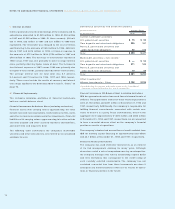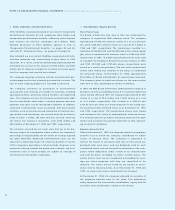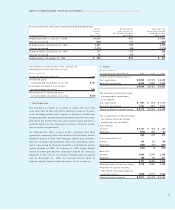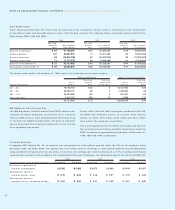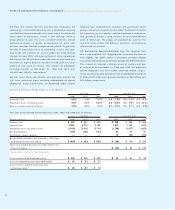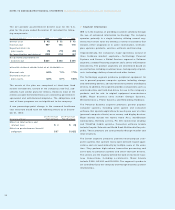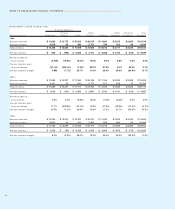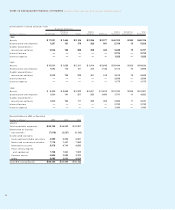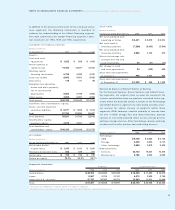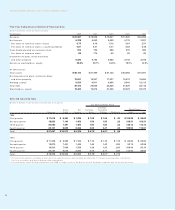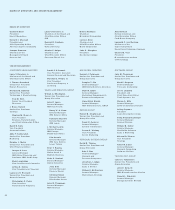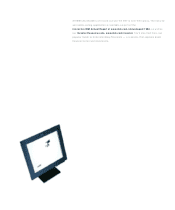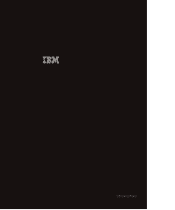IBM 1998 Annual Report Download - page 86
Download and view the complete annual report
Please find page 86 of the 1998 IBM annual report below. You can navigate through the pages in the report by either clicking on the pages listed below, or by using the keyword search tool below to find specific information within the annual report.
NOTES TO CONSOLIDATED FINANCIAL STATEMENTS International Business Machines Corporation and Subsidiary Companies
84
YSegment Information
IBM is in the business of providing customer solutions through
the use of advanced information technology. The company
operates primarily in a single industry utilizing several seg-
ments that create value by offering a variety of solutions that
include, either singularly or in some combination, technolo-
gies, systems, products, services, software and financing.
Organizationally, the company’s major operations consist of
three hardware product segments— Technology, Personal
Systems and Server; a Global Services segment; a Software
segment; a Global Financing segment and a series of Enterprise
Investments. The product segments are determined based on
several factors including customer base, homogeneity of prod-
ucts, technology, delivery channels and other factors.
The Technology segment produces peripheral equipment for
use in general purpose computer systems including storage
and networking devices, advanced function printers and display
devices. In addition, the segment provides components such as
semiconductors and hard disk drives for use in the company’s
products and for sale to original equipment manufacturers
(OEM). Major business units include Storage Systems,
Microelectronics, Printer Systems and Networking Hardware.
The Personal Systems segment produces general purpose
computer systems, including some system and consumer
software, that operate applications for use by one user at a time
(personal computer clients), or as servers, and display devices.
Major brands include the Aptiva home PC’s, IntelliStation
workstations, Netfinity servers, PC 300 commercial desktop
and ThinkPad mobile systems. Consumer software brands
include Crayola, Edmark and World Book Multimedia Encyclo-
pedia. These products are sold primarily through reseller and
retail channels.
The Server segment produces powerful multi-purpose com-
puter systems that operate many open-network based appli-
cations and are used primarily by multiple users at the same
time. They perform high-volume transaction processing and
serve data to personal systems and other end-user devices.
The servers are the engines behind the bulk of electronic busi-
ness transactions, including e-commerce. Major brands
include S/390, AS/400 and RS/6000. The segment’s products
are sold directly by the company and through business partner
relationships.
The net periodic postretirement benefit cost for the U.S.
plan for the years ended December 31 included the follow-
ing components:
(Dollars in millions) 1998 1997 1996
Service cost $«««42 $«««32 $«««43
Interest cost 427 455 478
Expected return on
plan assets (5) (15) (68)
Net amortization and deferral (133) (119) (87)
Net periodic postretirement
benefit cost $«331 $«353 $«366
WEIGHTED-AVERAGE ASSUMPTIONS AS OF DECEMBER 31:
Discount rate 6.5% 7.0% 7.75%
Expected return on
plan assets 5.0% 5.0% 9.25%
The assets of the plan are comprised of short-term fixed
income investments. Certain of the company’s non-U.S. sub-
sidiaries have similar plans for retirees. However, most of the
retirees outside the United States are covered by government-
sponsored and administered programs. The obligations and
cost of these programs are not significant to the company.
A one percentage-point change in the assumed healthcare
cost trend rate would have the following effects as of Decem-
ber 31, 1998:
One Percentage One Percentage
(Dollars in millions) Point Increase Point Decrease
Effect on total service and
interest cost $«««4 $«««««(6))
Effect on postretirement benefit
obligation $«87 $«(122)


